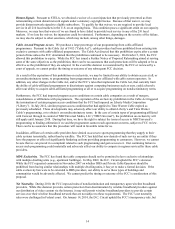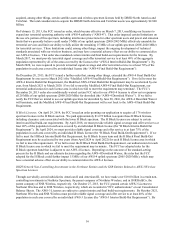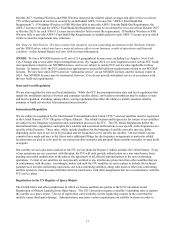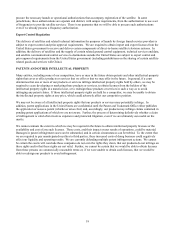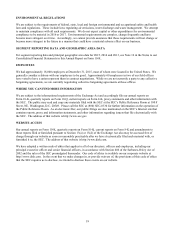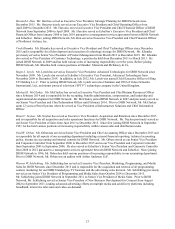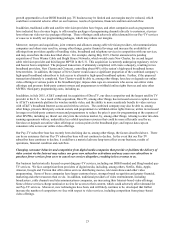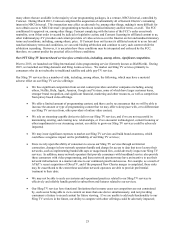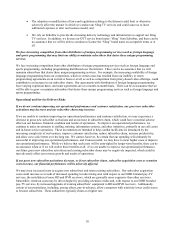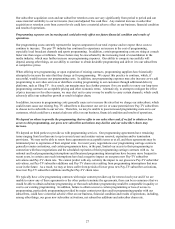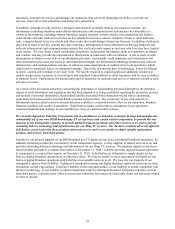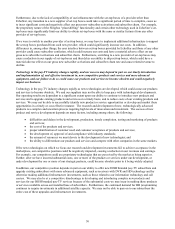Dish Network 2015 Annual Report Download - page 32
Download and view the complete annual report
Please find page 32 of the 2015 Dish Network annual report below. You can navigate through the pages in the report by either clicking on the pages listed below, or by using the keyword search tool below to find specific information within the annual report.22
Steven E. Swain. Mr. Swain has served as Senior Vice President and Chief Financial Officer of DISH Network since
October 2014. Mr. Swain served as our Senior Vice President of Programming from April 2014 to October 2014,
overseeing the acquisition and renewal of all programming content for DISH Network. Mr. Swain joined DISH Network
in 2011 as Vice President of Corporate Financial Planning and Analysis. Prior to DISH Network, Mr. Swain spent more
than 15 years working in the telecommunications sector, most recently at CenturyLink, formerly Qwest
Communications, where he served in multiple leadership roles in finance, including corporate financial planning and
analysis, treasury and investor relations, as well as in network engineering.
John W. Swieringa. Mr. Swieringa has served as Executive Vice President, Operations since December 2015 and is
responsible for the In-Home Services organization, customer service and billing, and information technology for DISH
Network. Mr. Swieringa previously served as Senior Vice President and Chief Information Officer from March 2014 to
December 2015 and as Vice President of Information Technology Customer Applications from March 2010 to March
2014. Mr. Swieringa joined DISH Network in December 2007 serving in our finance department. Before joining DISH
Network, Mr. Swieringa held corporate finance positions in various Fortune 500 companies.
There are no arrangements or understandings between any executive officer and any other person pursuant to which any
executive officer was selected as such. Pursuant to the Bylaws of DISH Network, executive officers serve at the
discretion of the Board of Directors.
Item 1A. RISK FACTORS
The risks and uncertainties described below are not the only ones facing us. If any of the following events occur, our
business, financial condition or results of operations could be materially and adversely affected.
Competition and Economic Risks
We face intense and increasing competition from satellite television providers, cable companies and
telecommunications companies, especially as the pay-TV industry has matured and bundled offers have become more
prevalent, which may require us to further increase subscriber acquisition and retention spending or accept lower
subscriber activations and higher subscriber churn.
Our business has historically focused on providing pay-TV services and we have traditionally competed against satellite
television providers and cable companies, some of whom have greater financial, marketing and other resources than we
do. Many of these competitors offer video services bundled with broadband, wireless services, HD offerings, interactive
services and video on demand services. Bundled offers combining video, broadband and/or wireless services have
become more prevalent and competitive. In some cases, certain competitors have been able to potentially subsidize the
price of video services with the price of broadband and/or wireless services. With respect to our DISH branded pay-TV
services, we and our competitors increasingly must seek to attract a greater proportion of new subscribers from each
other’s existing subscriber bases rather than from first-time purchasers of pay-TV services. In addition, because other
pay-TV providers may be seeking to attract a greater proportion of their new subscribers from our existing subscriber
base, we may be required to increase retention spending or we may provide greater discounts or credits to acquire and
retain subscribers who may spend less on our services. If our Pay-TV ARPU decreases or does not increase
commensurate with increases in programming or other costs, our margins may be reduced and the long-term value of a
subscriber would then decrease. In addition, our Sling TV subscribers generally have lower priced programming
packages than our DISH branded pay-TV subscribers. Accordingly, an increase in Sling TV subscribers has a negative
impact on our Pay-TV ARPU.
Competition has intensified in recent years as the pay-TV industry has matured and the growth of fiber-based pay-TV
services offered by telecommunications companies such as Verizon and AT&T continues. These fiber-based pay-TV
services have significantly greater capacity, enabling the telecommunications companies to offer substantial HD
programming content as well as bundled services. This increasingly competitive environment may require us to increase
subscriber acquisition and retention spending or accept lower subscriber activations and higher subscriber
churn. Further, as a result of this increased competitive environment and the maturation of the pay-TV industry, future




